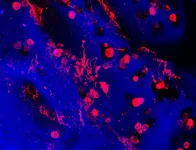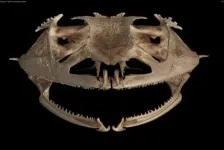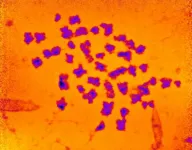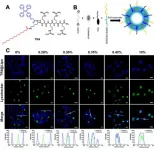Mini bone marrow model predicts response to blood disorder treatment
Scientists have described a miniature 3D bone marrow model that can both predict the response of patients to a new therapy for blood platelet disorders and facilitate studies to better understand these disorders
2021-06-01
(Press-News.org) A new miniature 3D model of human bone marrow has been described today in the open-access eLife journal.
The model may help clinicians predict which patients will benefit from a new therapy for blood platelet disorders, such as Inherited Thrombocytopenias - a group of familial disorders that inhibit the production of platelets. It could also enable further study of these disorders and give scientists a new tool to test experimental treatments.
Platelets are cells that are necessary for the blood to clot and stop bleeding. Having too few platelets can lead to internal or serious bleeding after surgery or injuries, which is usually treated with therapies that cause clotting. Recent studies have shown that a drug called Eltrombopag increases the production of platelets, but not all patients appear to benefit from it. "Patients with the same apparent form of platelet disorder may respond differently to treatment with Eltrombopag," says first author Christian Di Buduo, Research Assistant Professor at the Department of Molecular Medicine, University of Pavia, Italy.
To help determine which patients might benefit from the drug, Di Buduo and colleagues developed a mini 3D model of human bone marrow that combines a scaffolding of silk protein and culture of patient-derived cells to recreate the human bone marrow environment where platelets are produced. "This device is a significant improvement over previous models, requiring only a very small sample of blood to recreate platelet production," Di Buduo explains.
The team then tested what happened when they added Eltrombopag to a blood sample from a patient with a platelet disorder that had previously been treated with the drug. Their results showed that the number of platelets produced in the model corresponded to how each patient had responded to treatment with Eltrombopag. The increase in the number of platelets collected from the model was comparable to the increase in the number of platelets in patients' blood following treatment.
The authors say the model could eventually lead to personalised treatment for platelet disorders by helping clinicians match patients to the best treatment.
"This easy-to-reproduce system may also help scientists better understand what goes wrong in these disorders and how treatments work, as well as provide them with a new tool for testing new drugs that may lead to improved therapies in the future," concludes senior author Alessandra Balduini, Principal Investigator and Professor at the University of Pavia.
INFORMATION:
Media contact
Emily Packer, Media Relations Manager
eLife
e.packer@elifesciences.org
+44 (0)1223 855373
About eLife
eLife is a non-profit organisation created by funders and led by researchers. Our mission is to accelerate discovery by operating a platform for research communication that encourages and recognises the most responsible behaviours. We aim to publish work of the highest standards and importance in all areas of biology and medicine, while exploring creative new ways to improve how research is assessed and published. eLife receives financial support and strategic guidance from the Howard Hughes Medical Institute, the Knut and Alice Wallenberg Foundation, the Max Planck Society and Wellcome. Learn more at https://elifesciences.org/about.
To read the latest research in Medicine published in eLife, visit https://elifesciences.org/subjects/medicine.
[Attachments] See images for this press release:

ELSE PRESS RELEASES FROM THIS DATE:
2021-06-01
A college education is estimated to add $1 million to a person's lifetime earning potential, but for some students the path to earning one is riddled with obstacles. That journey is even more difficult for students who have been in the foster care system or experienced homelessness, according to a new study from the University of Georgia.
But the more college administrators and faculty know about these students' problems, the more they can do to ease the burden.
Getting into universities in the first place can frequently be a challenge for students who've had unstable home lives, said David Meyers, co-author of the study.
"Research tells us that every time a student moves from one foster care placement to another, they lose six months of educational ...
2021-06-01
In recent months, more than three hundred cases of salmonellosis have occurred in various European countries and Canada, which are linked to each other. In the UK the cases could be partly traced back to frozen breaded poultry meat. The cause was contamination with the bacterium Salmonella Enteritidis, which causes gastrointestinal inflammation. Salmonella is not killed by deep freezing and can remain infectious at temperatures below zero degrees Celsius. The Robert Koch Institute (RKI) and the BfR are monitoring the situation together with the Federal Office of Consumer Protection and Food Safety (BVL). In Germany, the number of reported cases has currently ...
2021-06-01
GAINESVILLE, Fla. --- Scientists have long known that frogs are oddballs when it comes to teeth. Some have tiny teeth on their upper jaws and the roof of their mouths while others sport fanglike structures. Some species are completely toothless. And only one frog, out of the more-than 7,000 species, has true teeth on both upper and lower jaws.
Now, the first comprehensive study of tooth evolution in frogs is bringing the group's dental history into focus. Florida Museum of Natural History researchers analyzed CT scans of nearly every living amphibian genus to reveal that frogs have lost teeth over 20 times during their evolution, more than any ...
2021-06-01
DANVILLE, Pa. - Among people who have strokes and COVID-19, there is a higher incidence of severe stroke as well as stroke in younger people, according to new data from a multinational study group on COVID-19 and stroke, led by a team of Geisinger researchers.
The COVID-19 Stroke Study Group's latest report, published in the journal END ...
2021-06-01
LAWRENCE -- In the early days of COVID-19 vaccine development, a new social media platform provided a place for like-minded people to discuss vaccines, share misinformation and speculate about the motivations for its development. A new study from the University of Kansas shows people flocked to Parler to discuss the vaccines in an echo chamber-type environment, and those conversations can shed light about how to communicate about vaccine efficacy during health crises.
COVID-19 vaccine vial and syringe photo from the U.S. Census Bureau.In the runup to the 2020 election, then-president Donald Trump claimed a COVID-19 vaccine could be ready before ...
2021-06-01
Mass of human chromosomes measured for the first time
The mass of human chromosomes, which contain the instructions for life in nearly every cell of our bodies, has been measured with X-rays for the first time in a new study led by UCL researchers.
For the study, published in Chromosome Research, researchers used a powerful X-ray beam at the UK's national synchrotron facility, Diamond Light Source, to determine the number of electrons in a spread of 46 chromosomes which they used to calculate mass.
They found that the chromosomes were about 20 times ...
2021-06-01
Scientists have revealed a potential mechanism for how traumatic brain injury leads to neurodegenerative diseases, according to a study in fruit flies, and rat and human brain tissue, published today in eLife.
The results could aid the development of treatments that halt the progression of cell damage after brain injury, which can otherwise lead to neurological diseases such as amyotrophic lateral sclerosis (ALS), and Alzheimer's and Parkinson's disease.
Repeated head trauma is linked to a progressive neurodegenerative syndrome called chronic ...
2021-06-01
Since the introduction on the market in 1995 of Doxil, pegylated liposomal doxorubicin, liposomes have become one of the most clinically established drug delivery systems in nanomedicine. Among different liposomal formulations, cationic liposomes have attracted great attention because of their capacity to bind negatively charged nucleic acids to perform as non-viral gene delivery tools, and due to their potentials to fuse with cell membranes leading to a direct release of cargoes from liposomes into the cytoplasm and high drug delivery efficiency. However, in most cases, the drug/gene delivery and therapeutic efficacy by cationic liposomes are evaluated ...
2021-06-01
A new study led by Kent Business School, University of Kent, finds that whilst the mumpreneur identity may enable women to participate in the business world and be recognised as 'proper' entrepreneurs, this success is dependent on alignment with the conventional masculine norms of entrepreneurship.
These conventional masculine behaviours include working long hours and an ongoing dedicated commitment to the success of a business.
Published in the International Small Business Journal and based on an interview study of women business owners, the study highlights the interviewees' belief that entrepreneurship and motherhood ...
2021-06-01
Firefighting is a race against time. Exactly how much time? For firefighters, that part is often unclear. Building fires can turn from bad to deadly in an instant, and the warning signs are frequently difficult to discern amid the mayhem of an inferno.
Seeking to remove this major blind spot, researchers at the National Institute of Standards and Technology (NIST) have developed P-Flash, or the Prediction Model for Flashover. The artificial-intelligence-powered tool was designed to predict and warn of a deadly phenomenon in burning buildings known as flashover, when flammable materials in a room ignite almost simultaneously, producing a blaze only limited in size by available oxygen. The tool's predictions are ...
LAST 30 PRESS RELEASES:
[Press-News.org] Mini bone marrow model predicts response to blood disorder treatment
Scientists have described a miniature 3D bone marrow model that can both predict the response of patients to a new therapy for blood platelet disorders and facilitate studies to better understand these disorders




